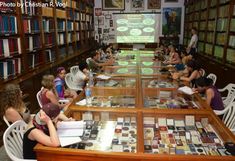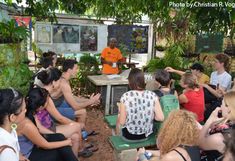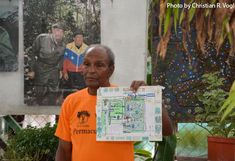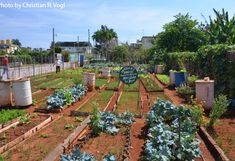Im März 2015 fand die zweiwöchige Interdisziplinäre Exkursion zur Ökologischen Landwirtschaft in KUBA statt. 16 Studierende der BOKU, Dipl.-Ing. Friedrich Leitgeb und Ao.Univ.Prof.Dr. Christian R. Vogl vom Institut für Ökologische Landwirtschaft, Arbeitsgruppe Wissenssysteme und Innovationen, erkundeten dort die ökologische und urbane Landwirtschaft. Sie besuchten Bauernhöfe und Produktionseinheiten verschiedener Betriebsformen und -größen sowie landwirtschaftliche Institutionen. ACKNOWLEDGMENTS
Die Erlebnisse der Exkursion sind hier im Weblog in englischer Sprache nachzulesen und in den Bildergalerien nachzusehen. Für vollständige und größere Ansicht, bitte die jeweilige Galerie anklicken.
Die Arbeitsgruppe Wissenssysteme und Innovationen hat einen ihrer Regionalschwerpunkte in Kuba. Neben Forschungsprojekten, Masterarbeiten österr. StudentInnen in Kuba (Elena Sanz-Soro, Katrin Hasenhündl, Sarah Schneider, Maria Mayrhoffer, Christiane Ringler) und spannenden Exkursionen in den Jahren 2012 & 2014 besuchen Studierende der BOKU auch im März 2015 Kuba. Besichtigt werden die hot spots der Stadtlandwirtschaft und der Permakultur in Havanna sowie der ökologischen Landwirtschaft in den Nachbarprovinzen Havannas. Ergebnisse dieser Exkursion werden eine Fotoausstellung an der BOKU, ein Video und eine Radiosendung zu den genannten Themen sein.
WEBLOG
Friday, 27th March 2015 On our last day in Cuba we visited the University of Havana again. Established in 1728, the University of Havana is one of the first to be founded in the Americas and consists of 16 faculties. The different fields of teaching and research are: economics, natural sciences, social science and humanities. At the main entrance of the splendiferous building we observed a bronze statue of Alma Mater (Latin: nourishing mother), created in 1919 by Mario Korbel. She has her arms widely spread to welcome the 25,000 students and 4,100 professors of the university. We also had the chance to visit the interior of several buildings, for example the main auditorium where seven impressive frescos made by Armando Menocal y Menocal are located. These represent medicine, science, art, thoughts, liberal art, literature and law. Then we had the possibility to talk to different professors from the plant physiology and genetics department and from the center for research on the environment. The scientists are working together with several state ministries to do research on a diversity of topics relevant for the development of the country. We were talking about self-sufficiency of Cuba related to food, on the production of alternative energy, supply chains for agricultural products and other topics. Currently Cubans eat 60 kg rice per person per year or a lot of bread made of wheat, too much to be produced in Cuba or based on crops that do not grow in Cuba. To cap the national supply (e.g. for milk), Cubans would have to increase for example milk production, but consequently also increase the pasture areas and the processing capacities – yet tasks too demanding for the country. After talking to the professors the head of the university, Gustavo Cobreiro Suárez, gave us a warm welcome. We had a last lunch together as a group and reflected our two weeks of the excursion. We all agreed on how much we’ve learned from the local farmers and farms we visited. Especially learning by watching and doing gave us a lot of specific knowledge on the different topics: agro ecology, organic farming, urban and per urban agriculture and permaculture.
-
 10 Bilder
10 BilderDeutschkurs: österreichische und kubanische StudentInnen arbeiten in Kleingruppen -
 10 Bilder
10 BilderDeutschkurs: österreichische und kubanische StudentInnen arbeiten in Kleingruppen -
 10 Bilder
10 BilderDeutschkurs: österreichische und kubanische StudentInnen arbeiten in Kleingruppen -
 10 Bilder
10 BilderDeutschkurs: österreichische und kubanische StudentInnen arbeiten in Kleingruppen -
 10 Bilder
10 BilderDeutschkurs: österreichische und kubanische StudentInnen arbeiten in Kleingruppen -
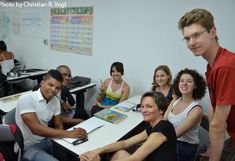 10 Bilder
10 BilderDeutschkurs: österreichische und kubanische StudentInnen arbeiten in Kleingruppen -
 10 Bilder
10 BilderDeutschkurs: Deutschprofessorin Taycel -
 10 Bilder
10 BilderFranchi erklärt mit Begeisterung -
 10 Bilder
10 BilderFranchis berühmter Bewässerungsautomat -
 10 Bilder
10 BilderFranchi setzt Alternativenergie ein (Wind, Sonne)
Thursday, 26th March 2015 It was Thursday and we were shocked when we recognized that it was already the second last day of our fascinating excursion. After breakfast we went by maquinas to the University of Havana. There we visited a German language and literature class during their lesson with their teacher Tacel. In small mixed groups (Cubans, Austrians) we talked in German about our families and life as students in Austria and Cuba. For us it was very interesting to hear about the life of Cubans like family life, leisure activities and food preparing. We learned how difficult it is to access internet: how expensive, slow and unreliable it is. One hour access to internet costs a quarter of the average monthly salary of a Cuban. Only journalists, teachers, embassies and people working in the government have access to the “World Wide Web”. Later on we visited a farm: La Joya is a half an hour’s drive away from Havana. Getting there was quite an adventure. The bus company had cancelled our bus and therefore we made our way by foot, bus and in maquinas. The farmer showed us his photovoltaic system, which allows him to produce electricity and to pump ground water into a 10 thousand litre tank, placed six meters above the ground. Proudly he presented us his watering system that he invented and patented by himself. For his system he used recycled materials, like old steal and a plastic bottle. The only expensive part of the entire device was the ball valve. With this intelligent watering system one can control the amount of water through regulating the interval of irrigation. On top of that, most of us saw for the first time in real life, how cinnamon grows and is harvested. On that evening the dinner was a very special one. We were invited to the residence of the Austrian Ambassador Gerlinde Paschinger and had the chance to chat with the ambassador, her husband and their daughter. It was interesting to learn more about the duties and obligations of an ambassador and about their view on Cuba. During the last weeks, since the USA has again taken up relations with Cuba, the embassy got many phone calls from Austrian companies, trying to get information about opportunities and possible problems if investing in Cuba.
Wednesday, 25th March 2015 Our day started at the Foundation Antonio Nienez Jimenez de la Natura y hombre, a NGO founded in 1995 for the conservation of natural resources and the promotion of permaculture. Principles of permaculture are – among other – working together with nature, minimal use of resources, closed nutrient cycles, low energy use, increased subsistence and avoiding the production of “waste”. 75 % of Cuban citizens are living in urban areas: Especially here permaculture is quite important for food production and the conservation of natural resources in cities. In the afternoon we then were able to visit the permaculture sites of several members of the permaculture movement. These were great gardens and patios aiming for sells consumption of high quality food, full of plant diversity and nicely designed. With a lot of new impressions we left the sites and took the bus back to our casa particulares, preparing ourselves for a reflection round at the Berthold Brecht, a famous music institution.
-
 10 Bilder
10 BilderAm Weg nach Pinar del Rio 1 -
 10 Bilder
10 BilderAm Weg nach Pinar del Rio 2 -
 10 Bilder
10 BilderAm Weg nach Pinar del Rio 3 -
 10 Bilder
10 BilderAm Weg nach Pinar del Rio 4 -
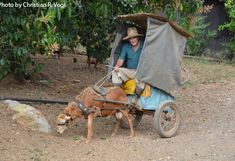 10 Bilder
10 BilderHauszustellung in Pinar del Rio. -
 10 Bilder
10 BilderWer werden "zurückgefilmt". -
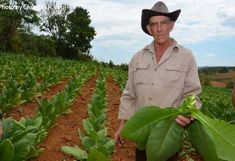 10 Bilder
10 BilderAugustin erklärt die Tabakernte. -
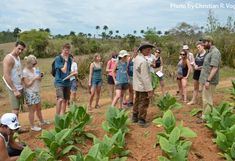 10 Bilder
10 BilderAugustin erklärt... -
 10 Bilder
10 BilderBiogasanlage von Augustin & Maria -
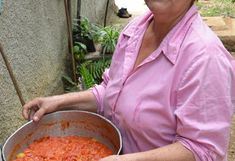 10 Bilder
10 BilderMaria erklärt die Verarbeitung von Tomaten.
Tuesday, 24th March 2015 After starting with traditional Cuban Guyaba Croissants, we took the bus to Pinar de Rio, three hours from Havana. We passed through beautiful landscapes and observed tobacco and rice fields. At the farm of Augustín and Maria we got a warm welcome and were introduced to the PIAL project (Proyecto de Innovación Agricola Local) and the participatory plant breeding project run at this farm together with many other farmers and with the National Institute for Agriculture research (INCA). In these projects agroecological practices are exchanged between farmers through the “farmer to farmer” approach, crop varieties are tested in situ by farmers and innovations built upon farmers’ experiments. We learned also a lot about tobacco, for example on production, harvesting, drying procedures and fermentation. Interestingly the usage of synthetic pesticides in tobacco is obligatory in Cuba. Nevertheless, our host neglects this demand, refuses to apply pesticides and therefore grows “organic” tobacco.
Monday, 23rd March 2015 Today we met scientists from the INIFAT, the Institute of Tropical Agriculture, that is the coordinating institution for urban farming in Cuba. Señor Daniel Balmaseda, an expert on urban agriculture and suburban agriculture gave us a presentation about urban agriculture and suburban agriculture, their principles, progress, perspectives and social impacts. We also visited two small urban farming sites and talked to their managers. With 800 square meters of land each, they can support the diet of two families with around 16 family members and are able to earn some money with selling the surplus. They grow vegetables, herbs and fruits. It was a pity that part of our program failed in the afternoon – but “Cuban organisation” is another story that we will cover in our blog later.
Sunday, 22nd March 2015 Today we had some time to explore Varadero, we visited the beach and a handicraft market.
Later that day we visited the farm “La Placida” of Omar. When we arrived, Omar was already waiting for us with delicious fruits from his farm. After a very friendly welcome, he presented many interesting details on his farm. He showed us the irrigation system for his ornamental plant nursery and he explained the propagation of ornamental plants. He explained and showed the management of rabbits and the production of worm compost beneath the rabbit cages. Omar told us also many details on producing effective microorganisms (EM). Furthermore we learned how he feeds and keeps his pigs, his chicken how his biogas tank works. Especially impressive was seeing all the fruit plants, like Mangos, Guavas or Avocados. Sadly, we had to leave the farm in the evening and drive to Havana, where we checked in into casas particulares in Vedado.
Saturday, 21st March 2015 We took the bus to Varadero, aiming to see another part of Cuba. On our way we passed by beautiful landscapes and had the chance to get a lot of information about the history, economy and landscape from our tour guide. After check-in to our rooms at the hotel, we had the opportunity to work on our projects concerning the organic agriculture in Cuba. Our projects include a blog, a video, a cartoon, articles and a photo exhibition. We also used the time to discuss our last week’s experience, impressions and highlights.
-
 4 Bilder
4 BilderWährend der Exkursion wird ein Video über die Agrarökologie-Maßnahmen in Kuba gedreht. -
 4 Bilder
4 BilderSpannende und lehrreiche Diskussionen mit Schülerinnen des nahe gelegenen Gymnasiums, die im Vivero Alamar ein Praktikum machen. -
 4 Bilder
4 BilderTransport wird bewusst so weit wie möglich mit Zugtieren erledigt. -
 4 Bilder
4 BilderWir helfen beim Transport.
Friday, 20th March 2015 Today we all were very enthusiastic about going to Alamar a little bit earlier, to be able to do the harvesting for the sales point together with the field workers. Even we ourselves were surprised that almost everybody in our group was willing to sacrifice half an hour of sleep for that activity. But it was worth it. And at the end of our shift almost everybody joined in for the highlight of the day: Playing “Kale Ball”. We threw the best heads of the kale along a row of people. It’s a very efficient and funny method to get the harvest from one end of the field to the other. When harvesting was done we sat down with Señor Salcines for a very interesting talk about the aspects of the commercialization and the economical background of the cooperative. We got insights into the Cuban economy and market mechanisms. Especially some facts about Cuban reality and life were very astonishing. For an even deeper insight into Cuban culture we then talked to Cuban students from a local school. It was a very interesting exchange for all of us. As everything comes to an end at some point, we then had to say goodbye.
-
 15 Bilder
15 BilderBewässern der Anzuchtkästen und Behandlung mit effektiven Mikroorganismen. -
 15 Bilder
15 BilderWir lernen, wie im Vivero Jungpflanzen gezogen werden: Hier die Saat. -
 15 Bilder
15 BilderFür jede Charge neuen Saatguts werden Keimfähigkeitstests durchgeführt. -
 15 Bilder
15 BilderFertig gesäte und bewässerte Anzuchtkästen werden durch eine phytosanitäre Schleuse in das Anzuchthaus verbracht. -
 15 Bilder
15 BilderSelbstverständlich werden wir auch beim Auspflanzen der fertigen Jungpflanzen eingesetzt und lernen die notwendige Setztechnik. -
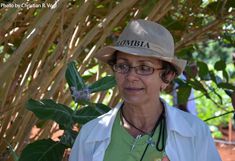 15 Bilder
15 BilderNorma erklärt kompetent den vorbeugenden und kurativen Pflanzenschutz. -
 15 Bilder
15 BilderBei informativen Gesprächen mit den Arbeitern Erfahren wir viel über die technischen und sozialen Aspekte ihrer Arbeit. -
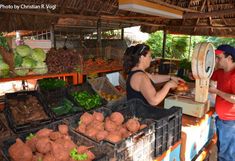 15 Bilder
15 BilderDie Produkte des Vivero werden an soziale Einrichtungen sowie über einen Verkaufsstand an die Nachbarschaft verkauft. -
 15 Bilder
15 BilderVermehrung von Nützlingen. -
 15 Bilder
15 BilderNorma erklärt im Vivero Alamar die Anwendung von Nützlingen für den vorbeugenden Pflanzenschutz. -
 15 Bilder
15 BilderHerstellung von Sprossen aus Mung-Bohnen. -
 15 Bilder
15 BilderHerstellung von Speisepilzen im Vivero Alamar. -
 15 Bilder
15 BilderEigene Erfahrungen Sammeln beim Schädlingsmonitoring in Melanzanikulturen. -
 15 Bilder
15 BilderAusbringung von Pflanzenpflegemitteln. -
 15 Bilder
15 BilderNorma ist beim Schädlingsmonitoring sehr genau ....
Thursday, 19th March 2015 It’s already our fifth day in Cuba and time is passing quickly. Directly after arriving at the organoponico in Alamar we got a great explanation about the production of sprouts and mushrooms. Our group was really impressed by the way they are produced in the Vivero Alamar. We also had the opportunity to learn more about the ingredients of organic pesticides. We were even allowed to produce some of it ourselves and spray it on the eggplant-plot after we had done a monitoring of the pests and diseases. We learned a lot about preventive measures for pest & disease control. After lunch we made a reflection upon our experiences so far and everybody exchanged impressions. Before going home we spent two hours at the beach. It was absolutely amazing, the ocean had beautiful colours: a light and a darker blue. While lying in the sand a Cuban music group came along and played for us.
-
 11 Bilder
11 BilderIn einem eigenen Bereich des Vivero Alamar werden Tomaten, Knoblauch und andere Kulturarten verarbeitet und (Foto) gelagert. -
 11 Bilder
11 BilderEines der Büros im Vivero Alamar. -
 11 Bilder
11 BilderEine Mitarbeiterin beim Verpacken des aus Bixa orellana gewonnenen roten Farbstoffes (u.a. zum Färben von Reis oder Tomatensauce). -
 11 Bilder
11 BilderReinigen der Flaschen, in die hier hergestellte Tomatensauce abgefüllt wird. -
 11 Bilder
11 BilderDie Auszahlung der Löhne und Gewinnbeteiligung alle 14 Tage erfolgt nach einem wohl überlegten, komplexen System, das u.a. Arbeitsbereich & Dauer der Tätigkeit der Mitglieder in der Genossenschaft berücksichtigt. -
 11 Bilder
11 BilderEingefasste Beete dienen überwiegend dem Erosionsschutz bei Starkregen. Sie sind erhöht, weil auf gartenbaulich schlecht nutzbaren Flächen so schnell Substrat und Bodenfruchtbarkeit zum Anbau aufgebaut werden können. -
 11 Bilder
11 BilderDie Arbeiter sind alle Mitglieder der Genossenschaft. -
 11 Bilder
11 BilderAm Vivero werden auch Ochsen als Zugtiere gehalten. -
 11 Bilder
11 BilderAnreise zum Vivero .... -
 11 Bilder
11 BilderErnte im Vivero Alamar im Morgengrauen. -
 11 Bilder
11 BilderWir lernen und üben die Vorbereitung der Anzuchtkästen vor der Aussaat.
Wednesday, 18th March 2015 After spending three nights in Havana we already had a morning ritual: Meeting at 7.00 am, having a Tortilla for breakfast and taking the maquinas to the organoponico. This day we had a very practical working session. We started sowing green pepper seeds. The cooperative has a very sophisticated and experienced management for sowing the seeds for all horticultural crops, growing them in a nursery greenhouse and then planting them in the raised beds. None of the raised beds stays empty for more than two days and all species are grown in a crop rotation together with plants that repel pests or help beneficial insects to develop. We also planted salad and were amazed by the practice used to plant the plantlets efficiently. While planting we talked a lot with the field workers (members of the cooperative). It was interesting to learn from the workers, not only by talking but by watching precisely how they do their work. One worker made a special impression on us: He told us how he fought with Fidel Castro and Che Guevara in the Revolution. He shared family pictures with us and showed us newspaper articles about the Revolution. In our break we enjoyed freshly squeezed Guarapo, the liquid made out of sugarcane mixed with ice. And we bought fresh carrots, tomatoes and beans. Most of us spent the evening in a traditional Cuban nightclub, where a Salsa & Merengue band was playing: We danced, we laughed, we had fun!
-
 7 Bilder
7 BilderWir bekommen die Herstellung von Wurmkompost erklärt. -
 7 Bilder
7 BilderDie Verarbeitung von organischem Material und Kompostherstellung ist eine wesentliche Strategie zur Sicherung der Bodenfruchtbarkeit. -
 7 Bilder
7 BilderWurmkompost wird direkt in den Kulturen ausgebracht, allerdings für die Anzucht von Saatgut/Jungpflanzen gesiebt. -
 7 Bilder
7 BilderUnter Bananenstauden wird intensiv gemulcht und die Bodenfruchtbarkeit aufrecht zu erhalten. -
 7 Bilder
7 BilderDie Mitglieder der Genossenschaft arbeiten von 7 bis 13 Uhr auf den Feldern und den Anlagen des Vivero Alamar. -
 7 Bilder
7 BilderEin Blick auf die "organoponicos" (erhähten Beete) des Vivero Alamar. -
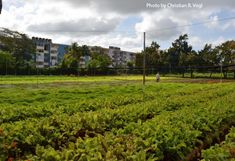 7 Bilder
7 BilderBlick auf die erhöhten Gemüsebette des Vivero Alamar, die die Nachbarschaft mit Gemüse versorgen.
Tuesday, 17th March 2015 We started our day full of excitement. Our expectations were fulfilled and we had another interesting day. The focus of this day was on making compost, worm compost and fertilization. We also visited the processing plant and learned more, for example about the preparation and use of dried tomatoes, dried garlic and other products made from these ingredients. After lunch we spent a wonderful afternoon at Santa Maria beach where we also made our evaluation of the day.
-
 6 Bilder
6 BilderUnser Frühstücks-Paladar: Brot mit Omelette, Fruchtsaft und Kaffee um umgerechnet 2 €. -
 6 Bilder
6 BilderWir fahren, wie viele KubanerInnen auch, mit maquinas/almendrones (Oldtimer Taxis) nach Alamar und zurück. -
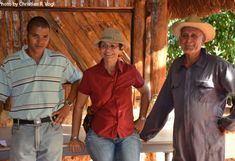 6 Bilder
6 BilderHerzliche Begrüßung im Vivero Alamar. -
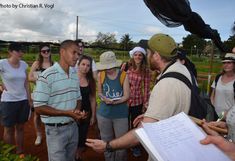 6 Bilder
6 BilderToni, im Vivero Alamar für die Koordination der Bildungsarbeit zuständig, erklärt uns wesentliche Aspekte der Organisation des Vivero. -
 6 Bilder
6 BilderGeruchsprobe: Salcines, einer der Gründer des Vivero Alamar, erklärt uns die Herstellung biologischer Pflanzenstärkungsmittel. -
 6 Bilder
6 BilderSalcines, seine enthusiastischen Erklärungen und seine Erfahrung begeistern uns.
Monday, 16th March 2015 Our day started at 7.00 am with searching for a breakfast. Luckily, near our casas particulares we found a paladar, a privately managed restaurant. Having breakfast just there gave us the chance to eat like many Cuban people usually do, at an affordable price. We had sandwiches, either filled with a tortilla or with ham. While standing there, several workers and students came, picking up their breakfasts as well and having fruit juices or coffee. After the breakfast we took maquinas (these are beautiful vintage cars in various colours, serving as taxis, which take always the same route – one can stop them by waving the hand) from the Parque Central to the urban cooperative farm Organoponico UBPC Vivero Alamar in Alamar. At the urban farm, Señor Salcines and Señora Romero were already awaiting us. They are both co-founders of the site and gave us a warm welcome and introduction about their organoponico. We learned many details about the cooperative’s history, the way how cooperatives are organized and how members collectively take decisions. Toni, responsible for training and education, guided us through the site and explained all steps of production including e.g. seed saving, sowing, growing plantlets, transplanting, organic fertilization, biological pest and disease management, weeding, harvest and commercialization. With many new impressions we enjoyed our lunch at a local restaurant and the afternoon was self-organized. We used the time to get to know Havana. At the end of the day the whole group met in a restaurant, having pizza and pasta and reflecting on the events of the first day.
Sunday, 15th March 2015 After a long journey we finally arrived – tired but happy – in downtown Havana. Some of us got there already a few days or hours earlier; the others came directly from the airport to our kick-off meeting at a restaurant in La Habana Vieja. The restaurant was a great opportunity to get to know each other better and to share our hopes and expectations regarding the excursion. Before check-in to our casas particulares (privately rent apartments), our home for the next week, we enjoyed the rest of the evening, having mojitos and traditional Cuban dishes.
Acknowledgments
We are very grateful to i) Lisandra Palenzuela (UH) & David, who helped organizing our trip; ii) the team of the Vivero Alamar (Eudes, Salcines, Norma, Carlos and all the other members of the cooperative), who arranged and facilitated our stay and allowed for many great experiences in the Vivero; iii) Taycel Martínez and her students that gave us many insights into the daily life of young Cuban students; iv) Lisandra Durán from the UH, together with the team of the Centre for International Relations, who arranged a great visit to the UH; v) Gustavo Cobreiro Suárez, the rector of the UH who is an enthusiastic support of the Austrian-Cuban academic friendship & collaboration; vi) The Austrian Ambassador Gerlinde Paschinger and her family for her support to our excursion and the great dinner at her residence; vii) Maiky Diaz Perez from the Cuban Embassy in Austria for her continuous and enthusiastic support to the activities of BOKU in Cuba, viii) Scientists at INIFAT and FANJ for very interesting conferences, ix) and finally all the farmers and their families who shared their experiences on agroecology, urban farming and permaculture with us.
Responsible for the Blog: Livia Zanella, Christian Frühwirth, Christina Kaasbauer, Christian R. Vogl, Friedrich Leitgeb, Maja Tumpej
BOKU professors leading the excursion: Friedrich Leitgeb and Christian R. Vogl





